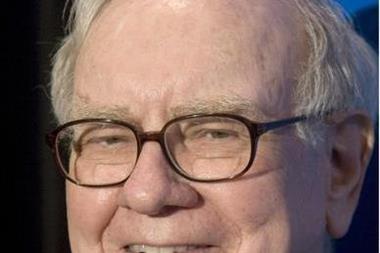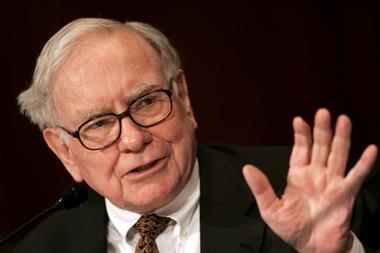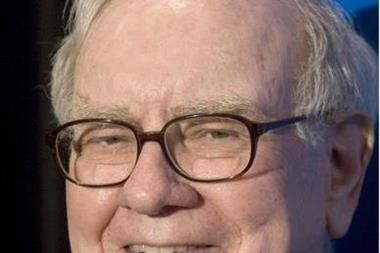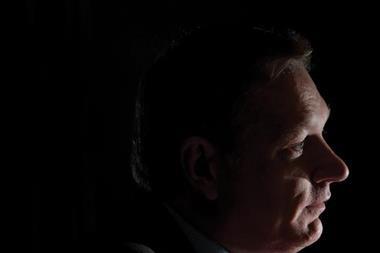Despite turning 80 later this year, Warren Buffett has no intention of slowing down if his recent stake in Munich Re is anything to go by. Here, we look at Buffett’s sprawling business empire, and where he may go next
Papers are all but stacked to the ceiling, and the offices are seemingly a shambles, according to one London market reinsurer. Yet this office in Stamford, Connecticut, houses part of the Berkshire Hathaway investment empire, run by billionaire Warren Buffett.
A quick call to the headquarters in Omaha, Nebraska, confirms the impression that a skeleton staff runs this $108bn-revenue (£72.3bn) conglomerate, which uses money generated from insurance policyholders to fund investments ranging from building materials to utilities. A quarter of the group’s overall revenue is derived from insurance premiums.
Huffing that there are only 20 staff in the building, the Berkshire Hathaway spokesman says that the company does not have the resources to answer Insurance Times’s enquiries.
But the London market is gagging for more information on Buffett’s intentions, as Berkshire Hathaway, already the world’s third-biggest reinsurer, is now making a play for a share of the European insurance and reinsurance sectors.
New strategies
Last month Buffett raised his stake in Munich Re to over 3%, which could become 5% – making Buffett the biggest shareholder – if options on other stock are converted. Buffett already holds 3% of Swiss Re’s shares. The moves show that Buffett believes European reinsurance stocks are good value and that the septuagenarian is preparing to make a killing on their likely growth.
JLT Re managing director Alistair Lockheart-Smith adds: “Circumstances have changed for Berkshire Hathaway, and therefore we’re seeing these different strategies to enhance earnings.”
Buffett is scaling back the group’s US catastrophe exposure. Munich and Swiss Re gives him access to their developing markets, including India, Africa and Asia.
One market source added that Berkshire Hathaway’s balance sheet might be “slightly stretched” as it completes a $26bn takeover of railroad operator Burlington Northern Santa Fe Corporation. The deal has led Standard & Poor’s (S&P) to downgrade Berkshire Hathaway’s coveted AAA credit rating to AA+. S&P argued that the increasingly complicated nature of the conglomerate meant that it was more difficult to ensure effective risk management.
This backs up analysts’ assertions that Munich Re’s strong balance sheet and stable results are among the company’s appeals for Buffett.
Gut instinct
Self-proclaimed ‘Buffettologist’ and devoted follower Justin Fuller (according to Fuller’s website, the so-called ‘Oracle of Omaha’ is “perhaps the greatest investor of our time, if not ever”) is a partner at Chicago-based investment adviser Midway Capital Research & Management. He says: “Swiss Re and Munich Re gives Buffett exposure to property and casualty markets. Insurance is still Berkshire Hathaway’s biggest business, so these investments dovetail nicely.”
Fuller also gives an insight into Buffett’s investment style, which appears to be low on due diligence and actuarial work but high on instinct for the way the market is turning, and so he can quickly pounce on bargains. “Berkshire Hathaway is hugely opportunistic. Buffett has people on the front line every day with their ears to the ground.”
The Berkshire Hathaway empire is vast. The guide below of Buffett’s insurance operations around the globe demonstrates just how much influence he will be able to bear upon the European market. Watch this space. IT
Mark Leftly is senior business reporter at the Independent on Sunday.
Berkshire Hathaway Primary Group (BHPG)
Buffett owns a number of primary insurers that the company tends to bunch into one group, BHPG, for the sake of simplicity in its accounts. These include the Central States Indemnity Company, which can provide supplemental life insurance for $1 a day; Kansas Bankers Surety Company, which has just 18 employees according to the 2008 accounts; and Boat America Corporation, the main supplier of insurance to BoatUS, the not-for-profit boater’s association. The division’s latest results, for the third quarter of last year, showed some weaknesses, with a 7% decline in premiums earned, to $442m.
Berkshire Hathaway Reinsurance Group (BHRG)
Indian Ajit Jain heads up a 31-strong team based in Stamford that Buffett describes as “one of the most remarkable businesses in the world; hard to characterise but easy to admire”. Despite so few staff, BHRG covers some of the biggest catastrophe insurance around, works in the UK through its contracts with Lloyd’s syndicates, and made a pre-tax underwriting gain of $79m for the first nine months of 2009, following a loss of $58m the previous year. BHRG is the world’s third-biggest reinsurer behind Swiss Re and Munich Re. Jain is widely viewed as a potential successor to Buffett.
Berkshire Hathaway Assurance Company (BHAC)
Formed in early 2008, BHAC is an insurer of tax-exempt bonds issued by states and cities in both primary transactions to the public and secondary deals when they are sold on. Buffett admitted in his 2009 letter to shareholders that it is a “far from sure thing that this insurance will be ultimately profitable for us”. Jain’s small reinsurance division runs the operation, with Buffett joking that the slimline group needed the extra work to ensure they started “doing a full day’s work”.
GEICO
The Maryland-based auto insurance business is much loved by Buffett. In Berkshire Hathaway’s last available annual report, for 2008, Buffett gushed that Tony Nicely “continues to gobble up market share” since becoming chief executive in 1993. Then, GEICO had just 2% of the market, which Nicely has since quadrupled. Nicely also exhibits the efficiency that Buffett so clearly craves, based on his reliance on skeleton staffing: in 2003 the number of policies per employee was 299, soaring to 439 five years later. It is still the most staffed of Buffett’s insurance groups, however, with more than 22,000 employees. GEICO provides coverage in every US state and wrote $12.74bn of premiums in 2008. Buffett is, to say the least, enthusiastic of GEICO’s prospects for acquisitive growth: “Tony and I feel like two hungry mosquitoes in a nudist camp. Juicy targets are everywhere.”
General Re/Cologne Re
Tracing its origins to the merger of two Norwegian companies in 1921, General Re formed an alliance with Cologne Re in 1994 and today owns a majority stake in the business. Berkshire Hathaway acquired General Re in 1998 and 10 years later it provided $342m of underwriting profit. A global operation, it has 45 offices and 1,900 employees across most major jurisdictions. As well as 19 offices in the USA and Canada, General Re has operations in Argentina, Australia, Austria, Brazil, China, Denmark, France, Germany, Hong Kong, India, Japan, Latvia, Lebanon, Mexico, New Zealand, Poland, Russia, Singapore, South Africa, South Korea, Spain, Taiwan and the UK.
Swiss Re
Berkshire Hathaway took a 3.2% stake in Swiss Re in 2008. This could ultimately turn into a 20% shareholding, however, in the unlikely event that Swiss Re is unable to pay back a SFr3bn (£1.86bn) loan that Berkshire Hathaway made in 2009. Swiss Re used the money to strengthen its balance sheet, as it was suffering through its exposure to the subprime mortgage collapse.
Munich Re
It was only last month that Buffett finally had to reveal just how much he owned of Munich Re: he finally crossed the 3% threshold where holdings must become public. The stake is worth around $1bn. Buffett started investing in the company two years ago, betting that reinsurance stocks were not valued highly enough in the wake of the financial crisis and a number of high-profile natural disasters. Munich Re chief executive Nikolaus von Bomhard said back in 2008 that he expected Buffett to be a long-term investor, and that analysis is proving correct. Although the potential of the stake raising to 5% has sparked rumours about Buffett’s ultimate intentions, a Munich Re spokesman said recently that the company is “pleased about every investor; that’s a confirmation of our sustainable strategy”.
Columbia Insurance Company/Nederlandse Reassurantie Groep (NRG)
Berkshire Hathaway subsidiary Columbia paid E272m (£246.39m) for Amsterdam-based NRG in mid-2008. Bought from financial services giant ING, the move gives Buffett access to the Dutch reinsurance market. ING stopped underwriting new business in 1993, however, meaning that Columbia will have to rebuild NRG if it is to gain a significant foothold in the market.
Non-insurance investments
As well as reinsurance, Berkshire Hathaway invests in a range of other sectors. The best known of these now is perhaps a 9.4% stake – and, as such, the company’s biggest shareholder – in US food conglomerate Kraft. Berkshire Hathaway publicly opposed Kraft’s protracted £11.9bn takeover of British confectioner Cadbury, though failed to force the deal’s collapse. Other investments include drinks giant Coca-Cola, financial services group American Express and healthcare products behemoth Johnson & Johnson.
Non-insurance businesses
At the end of 2008, Berkshire Hathaway had 28,188 employees across its insurance subsidiaries. Although insurance is the most financially crucial part of the conglomerate, Buffett in fact employs nearly nine times as many people in non-insurance businesses. Its manufacturing group includes Fruit of the Loom-branded apparel and leisure vehicle maker Forest River. Pre-tax profit in this group was $293m in the third quarter of last year, down 39% on the same period in 2008. In utilities and energy, which includes UK assets, Berkshire Hathaway made $8.4bn of revenue in the first nine months of 2009, down from $9.7bn in the same period the previous year.






































No comments yet